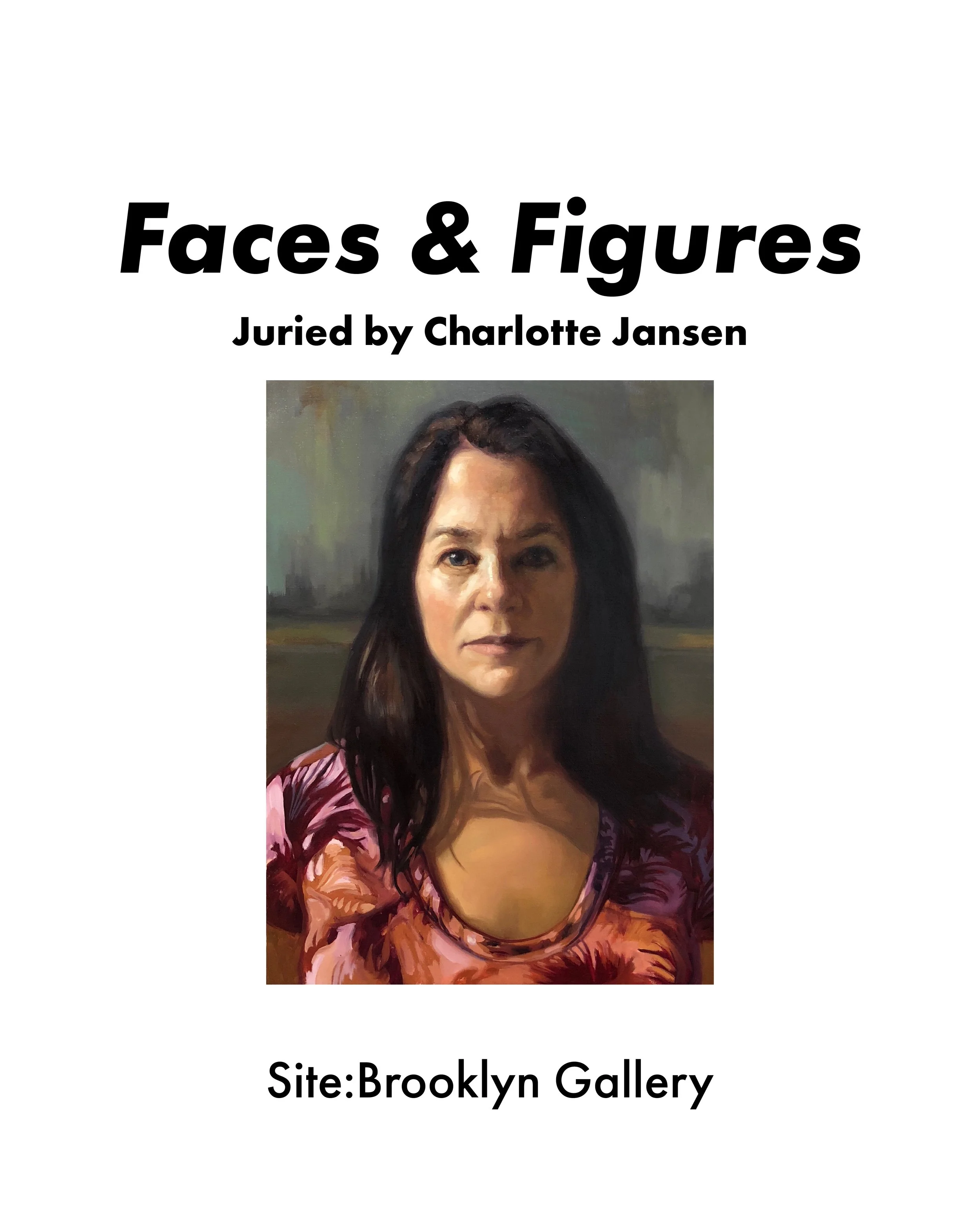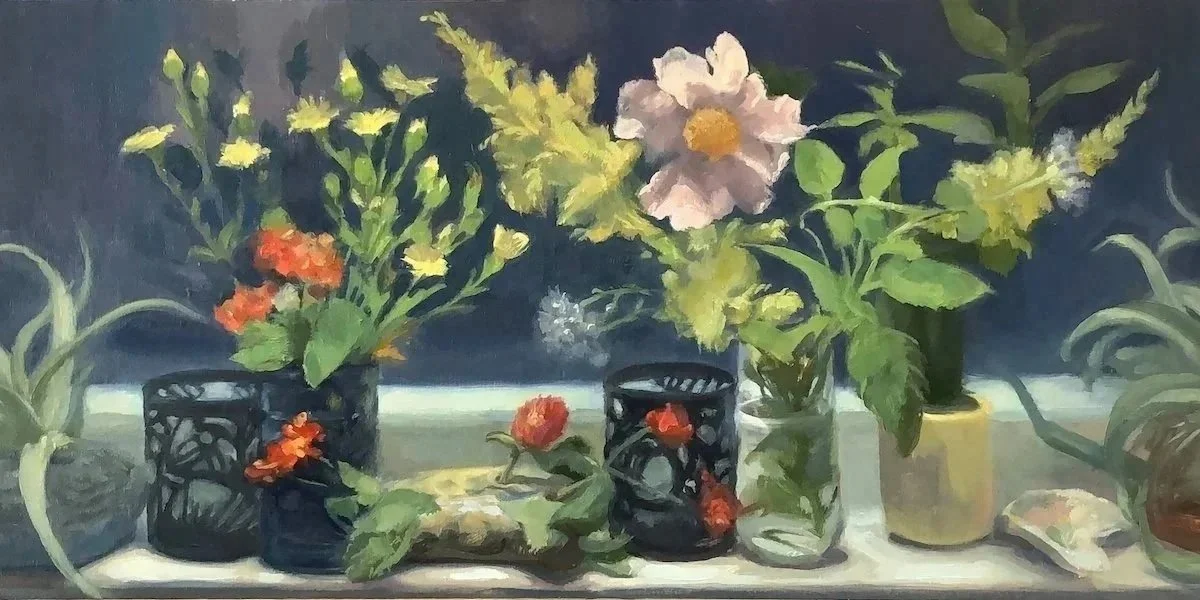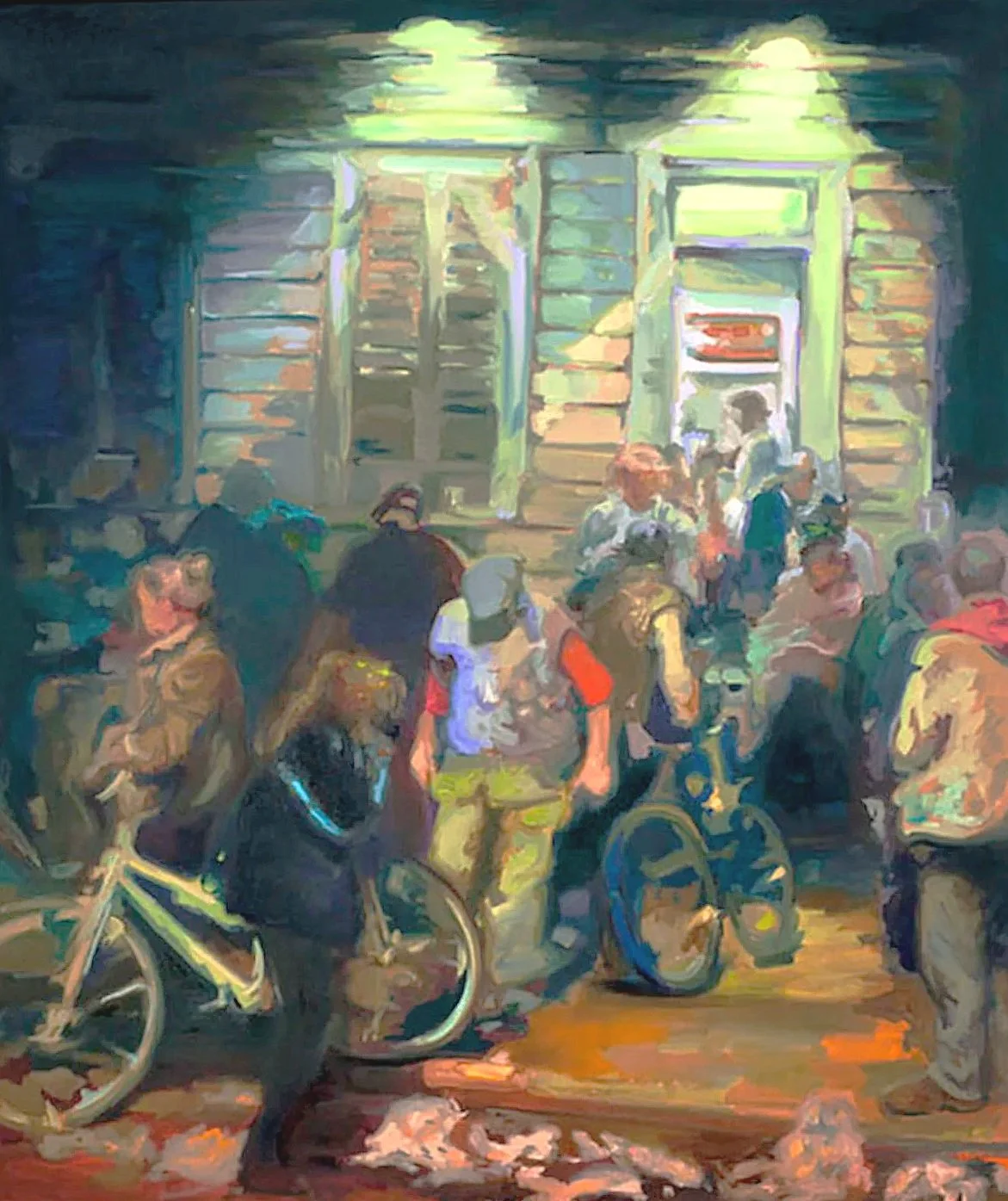Awards, Interviews, Articles
2025 Louisiana Tech University Research and Scholarship Award for Excellence in Creative Activity
The Louisiana Tech Research Division and the Research and Scholarship Council recognized eight outstanding mentors, researchers, scholars and creative artists at the Research & Scholarship Awards on April 23.
Pictured left to right are Early Career Excellence in Research winner Yang Xiao, Excellence in Mentoring Future Scholars winner Thomas Safford, Early Career Excellence in Scholarship winner Benjamin Bergholtz, Excellence in Creative Arts winner Nicole Duet, Early Career Excellence in Creative Arts winner Brooke Cassady, Leading Edge Award winner Lee Sawyer, Interim Vice President for Research Ramu Ramachandran, and Excellence in Research Julie Rutledge.
Image credit: @Emerald McIntyre, Louisiana Tech University
Interview with John R Kemp for Louisiana Life magazine. February 28, 2025
The Theater of Art
Ruston Artist Nicole Duet and the Confluence of Art and Life
February 28, 2025 by John R. Kemp
(https://www.louisianalife.com/author/johnrkemp/)
“Those who can, do; those who can’t, teach.” This snarky line from a 1905 play by George Bernard Shaw certainly doesn’t apply to artist Nicole Duet, an award-winning painter and long-time art professor at Louisiana Tech in Ruston, Louisiana.
Early in life, the New Orleans-born Duet dreamt of being an actor or perhaps a singer or writer. With that in mind, she studied theater at LSU and later at the University of New Orleans, where she had a part in Sam Shepard’s play “Fool for Love.” That was it. Duet was off to study acting at California State University Northridge. While there, she took an elective course in figure drawing. It changed her life. The moment came while sketching an older man.
“There was something poignant about the effort he took to step off the stand and grab a robe,” she says. “Looking back, I think it was a breakthrough in my own awareness, and the beginning of my love of drawing and painting. I realized that I could channel the very same love of exploring the dynamics of human nature that theater provided but through drawing and painting the figure.”
With her career now heading in a new direction, Duet earned a Master of Fine Arts in drawing and painting at Cal State Long Beach. After a brief time teaching art at colleges in the Los Angeles area, Duet headed back to Louisiana in 2011 to accept a faculty position at Louisiana Tech, where she now serves as chair of the studio art program and holds the impressive Louisiana Board of Regents’ Elva Leggett Smith Professorship in Liberal Arts.
On the art side of her parallel career, Duet’s paintings have appeared in juried exhibits from California to New York. She also has received numerous commissions and her work can be found in public and private collections in California and Louisiana.
Yet with all the career roads she has traveled, her early interest in theater is often evident in her paintings. Her softly focused and often faceless scenes resemble paused theatrical moments in a stage play or movie just before action resumes. As to style, she describes her approach to painting as “rooted in realism but also liberated from it.” Whether terms such as expressionistic, impressionistic, liberated realism or narrative figurative are used to describe her images, they are about stories, often everyday life stories. They draw viewers in, wanting to know more.
“It relates to the way narratives unfold in literature,” she says. “I’m a reader, and literature continues to be a big influence. Someone once said to me that great novels unfold like great paintings and great paintings read like great novels, and that’s a very formative idea for me. I want my work to have resonance the way poetry does.”
In her series “Ghost Cycles,”(above) for example, Duet had just returned to Louisiana and attended Mardi Gras in New Orleans for the first time in decades. While jostling among the crowds, she felt like a “tourist in my own hometown.” That experience triggered paintings that responded to how she felt “new and familiar” with the place she called home. It included dinner scenes with family and friends and shrines memorializing cyclists killed in accidents along New Orleans city streets.
A more recent shift in her work has produced what she describes as “smaller, more intimate and personal” and “less literal.” She says they are more reflective “metaphors” for what she observes. In this new work, she continues, the “composition is the story.” Her painting “Song of the Sea,” for instance, is about her aging father and her deep roots in New Orleans and the South.
“He is 89 now,” says Duet, “and the more we see signs of age the more poignant my awareness of the temporary nature of things is, and while in some ways the painting is about loss or the expectation of loss, it’s also about the fullness of life. Everything I’ve done since taking this position at Tech, my heritage as a New Orleanian is a core part of who I am as an artist. I want that aspect to be resonant and visible in the work but not the sole expression of the work. I believe in the voices of the South, in the richness of narrative in the South, and all their complexity, longing, beauty, tenderness and contradiction.”
How does Duet hope viewers respond to her work? “There are ways that painting touches the internal life of a viewer through sensation,” she says. And those sensations, she continues, open “the emotion and intellect.”
She recalls her first visit to the Getty Museum in Los Angeles and how it affected her. Exiting the museum, she found “the trees, the color of the sky, the textures or appearance of everything around me was heightened.” Painting, she says, has helped her see people, places and experiences of day-to-day life “in a different way.”
Indeed, Duet shows us how to truly see moments as stories in our own lives.
Image credit: Forrest McMullin, Hambidge Center for the Arts
Ruston’s Nicole Duet is the recipient of the Argent Fellowship for the Hambidge Center’s Creative Residency Program, recently renamed in honor of the late Annie Richardson
May 2024
Courtesy of Argent Financial Group
Argent Financial Group announced that Ruston artist Nicole Duet has been selected as this year’s recipient of the Argent Fellowship for the Hambidge Center’s Creative Residency Program. Duet will embark on her two-week residency at the Hambidge Center this summer.
Additionally, in remembrance and honor of their longtime friend and local Ruston artist Annie Richardson, who tragically passed away in November 2023, Argent has renamed the award The Annie Richardson Distinguished Fellowship at Hambidge.
“Annie Richardson was a very well-regarded artist who brought significant recognition to our local arts community. While the circumstances are heart-breaking, having the opportunity to memorialize her contributions to our whole community remains important to us,” said Kyle McDonald, CEO of Argent Financial Group.
The inaugural recipient of The Annie Richardson Distinguished Fellowship at Hambidge, Nicole Duet serves as Associate Professor of Drawing and Painting and as Chair of Studio Art at Louisiana Tech University School of Design. Duet specializes in observation-based painting and illustration, utilizing diverse media such as oil painting, watercolor, and silverpoint. Her artistic exploration is rooted in her fascination with the trustworthiness of perception, guided by her enduring conviction that the most profound discoveries arise from our ability to observe the subtle details of our surroundings.
“The chance to fully engage in one’s creative process is a rare and precious opportunity for any artist. My art is a reflection of my ongoing dialogue with life, a response to my daily experiences. I am excited to see how my time at Hambidge will ignite new ideas and inspire my artistic expression,” said Duet. “I am deeply grateful to Argent for this honor. I believe that making work is a way of finding one’s way through and communicating the indefiniteness of experience.”
Duet’s art has been showcased in museums and galleries nationwide, including CSU Los Angeles, the Long Beach Museum of Art, the Masur Museum, and the Dishman Museum at Lamar University. Her work is also featured in the public collections of CSU Long Beach and Los Angeles City College. She received her BA in Theater from California State University Northridge and her MFA in Drawing and Painting from CSU Long Beach.
“It continues to bring us great joy to engage with Hambidge in offering this fellowship, fostering the arts in our very own community,” said McDonald. “We are proud to support Nicole’s journey through this residency and, again, to honor Annie with the naming of this award in her honor this year and going forward.”











